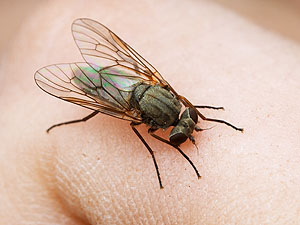
DEET is the main ingredient in most insect repellents. Slather it on and it's like magic; the mozzies just fly on by. Nothing else is as effective.
In spite of its utility, DEET is pretty nasty stuff. Depending on where you are in the world, you might be healthier just letting the bugs bite. It melts plastic, and I don't even want to think about what it does as it seeps into skin.
So, I was relieved this afternoon to read a report in this week's Science detailing the biochemical secrets behind DEET. Apparently, the chemical blocks an odor co-receptor called OR83b on insect antennae. When DEET is in the air insects can't smell you. You become, in effect, invisible.
With this new knowledge of the particular odor receptor, researchers can now try to design a molecule that acts like DEET in masking human odor but without the potential health effects. I hope they succeed- I always feel vaguely uneasy applying repellent.
photo details: Symphoromyia Snipe Fly, California.
Canon MP-E 65mm 1-5x macro lens on a Canon D60
f/13, 1/200sec, ISO 100.

There are a number of DEET alternatives I tried while working in seasonal wildlife. From the biting flies and midges of the PacNW to mozzies in the Mississippi Delta, desperation had me trying pretty much everything (including making my own). Most of the non-DEET products contain citronell, lemongrass, and of course geranium. My favorite was Herbal Armor, though re-application is needed every 2-3 hours.
I too only use Deet containing products sparingly. This seems to indicate that Deet has limited effectiveness providing protection against insects using a wider variety of indicator to know when a host is present -- like ticks.